Custom Shop: Abernethy Guitars
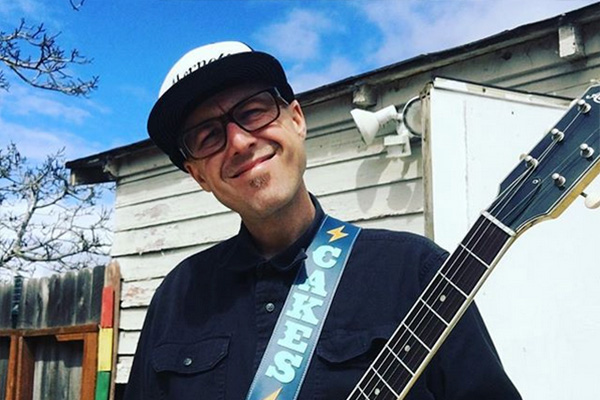
Justin Abernethy, the creator of Abernethy Guitars, has had no shortage of experience in the guitar industry. From working at a local repair shop to spending two years at a major manufacturing facility and everything in between, Justin has seen quite a lot. His multiple vantage points from within the industry have put him in a uniquely advantageous position for starting his own company. With Abernethy Guitars, Justin has been able to pick and choose the best pieces of his prior experiences in order to bring his own visions to life.
“I pretty much started working on guitars right out of high school. I got a job immediately working in a music store doing guitar repair. I wanted to build immediately, but there was just no outlet for it,” Justin says. For the next four years or so he honed his skills, learning everything from fretwork to electronics. “It was a ‘Right place at the right time’ kind of thing.” This seems to be a recurring theme for Justin.
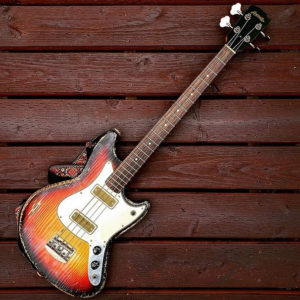 The music store eventually folded, but Justin’s knack for good timing led him straight into a new job working for Gene Baker. For those of you who haven’t heard of Gene, he is a sort of veteran amongst guitar luthiers. He has worked for both Gibson and Fender and was part of the Fender Custom Shop during what many consider to be its ‘golden years.’ “I immediately got on board,” says Justin. “I had never met him before, but I was like: ‘I’ll clean the toilets, I’ll do anything!’” So in 1999 on the Central Coast of California, Justin was a part of starting a new company with Gene called Baker Guitars.
The music store eventually folded, but Justin’s knack for good timing led him straight into a new job working for Gene Baker. For those of you who haven’t heard of Gene, he is a sort of veteran amongst guitar luthiers. He has worked for both Gibson and Fender and was part of the Fender Custom Shop during what many consider to be its ‘golden years.’ “I immediately got on board,” says Justin. “I had never met him before, but I was like: ‘I’ll clean the toilets, I’ll do anything!’” So in 1999 on the Central Coast of California, Justin was a part of starting a new company with Gene called Baker Guitars.
“It was like being thrown into the fire. He was setting up the shop while I was apprenticing. It was probably six months before I was even working on guitars. Since I had been doing fretwork, he taught me how to build the necks, which at the time, was done on the pin router and big shaper tables. So I kind of took over that department and over the course of a couple of years became really good at building the necks. In my opinion, the neck is the most important part; it’s the part that someone is going to handle the most.”
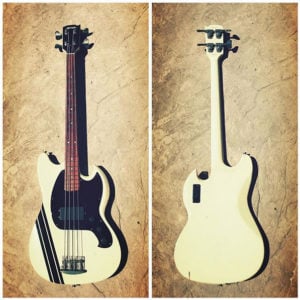 Baker Guitars lasted only a few years due to financial difficulties, and yet again Justin found himself looking for new opportunities. Luckily, Gene had friends at the Ernie Ball Music Man factory in San Luis Obispo and was able to get most of his employee’s new jobs. Justin had graduated from working repairs at a small music store to being a significant part of a small guitar-building operation, to now working at a fairly large guitar manufacturing facility.
Baker Guitars lasted only a few years due to financial difficulties, and yet again Justin found himself looking for new opportunities. Luckily, Gene had friends at the Ernie Ball Music Man factory in San Luis Obispo and was able to get most of his employee’s new jobs. Justin had graduated from working repairs at a small music store to being a significant part of a small guitar-building operation, to now working at a fairly large guitar manufacturing facility.
“I was fret-dressing all day long, ten or twelve necks a day, and I was the slow guy! In assembly, it was just like throwing these things together. One thing about Ernie Ball is that the engineering was so tight, that you literally could bolt a neck on, throw the strings on, and everything was just so close to being ready to go. I was literally assembling between twenty and thirty basses a day. So that was a trip. That was my first taste of a more corporate kind of thing.”
The fast-paced, assembly-line environment at Ernie Ball didn’t exactly suit Justin, however, and he soon found himself wanting to be more hands-on with instruments again.
“From Ernie Ball, I went to work at National Reso-Phonic which is basically just a few miles from Ernie Ball. That was a total 180. It was a really small, family-oriented shop. Ernie Ball could have been a great job for the rest of your life if you’re fine with doing monotonous things. I just couldn’t do it anymore, I got tired of that real fast. At National, it was like: ‘Here’s a chance to actually physically work on guitars again.’ No guitars are built like Nationals, the way they are constructed.”
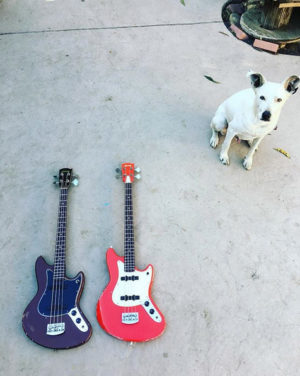 A couple of years later, Justin got a call from Gene Baker. Gene had started a new company, Fine Tuned Instruments, and was going to be building guitars again under the name B3. The new shop was much closer to home for Justin and he jumped at the opportunity to work for Gene again. “It was kind of like we got the band back together,” he says. Gene eventually got involved with some new partners and the company shifted focus and became a part of the Premier Builders Guild (PBG). The premise of PBG was that a handful of well-established small luthiers would each contribute guitar designs to be built by the workers at PBG. The goal was to produce affordable versions of fine, hand-crafted guitars. These guitars were built to nearly identical specifications as their handmade counterparts, but they were made much more quickly and sold for much lower prices.
A couple of years later, Justin got a call from Gene Baker. Gene had started a new company, Fine Tuned Instruments, and was going to be building guitars again under the name B3. The new shop was much closer to home for Justin and he jumped at the opportunity to work for Gene again. “It was kind of like we got the band back together,” he says. Gene eventually got involved with some new partners and the company shifted focus and became a part of the Premier Builders Guild (PBG). The premise of PBG was that a handful of well-established small luthiers would each contribute guitar designs to be built by the workers at PBG. The goal was to produce affordable versions of fine, hand-crafted guitars. These guitars were built to nearly identical specifications as their handmade counterparts, but they were made much more quickly and sold for much lower prices.
“It was too good to be true,” Justin says. He cites a variety of problems that ailed PBG, but ultimately it just wasn’t working out.
“It just kind of turned into a mess. Finally, I ended up getting laid off and about three months after that the shop shut down. Getting laid off was kind of a blessing in disguise. At that point, I had become really complacent, really kind of sick of it. The guitars didn’t mean anything to me anymore, it just wasn’t fun anymore. Meanwhile, I had built my first prototype, which was the first “Steed.” At the time I was just building it for myself. It was my two favorite guitars mashed together. I don’t think I really thought this was what I was going to do. At this point, I had been building guitars for over ten years, but I didn’t really think that I was going to start building my own guitars–until I got laid off.”
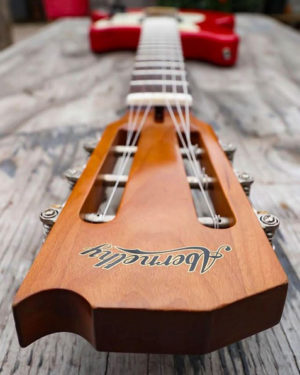
Armed with over a decade of experience and some tools of his own, Justin set up shop in Guadalupe, California and began designing his own line of instruments. He blends his love for Gibson guitars with the sensibility and familiarity of Fender designs to create some really unique and fun guitars. The Abernethy Steed is half SG, half Mustang. The Sonic Empress makes for a really cool short-scale bass reminiscent of a Jazz Bass or a Jaguar, but with a 2×2 headstock that tips its hat to the Gibson EB-series basses. But not all of his models have obvious influences. My personal favorite, the All Access, has a swooping, futuristic body, yet it would feel right at home amongst a stable of vintage classics.
A big part of Abernethy Guitars’s vintage appeal is the relic job. Justin has this down to a science. “I’m pretty methodical about it,” he says. “I’ll approach the guitar differently every time, but I will use the same tools and techniques.” Justin researches pictures of vintage guitars to figure out how to get the most authentic look and feel out of his own instruments. He will even go as far as breaking in the hardware and electronics in order to achieve that worn-in vibe.
Having worked for so long building other people’s guitars, it seems to me that Justin has finally found his true passion for designing and building his own. “Every instrument is so dear and so babied. I’m meticulous with every detail,” he says. It is exactly that passion that is necessary to create a quality instrument. Smaller brands like Abernethy are in a unique position to play with the boundaries of taste in guitar-making, and they are also flexible enough to tailor an instrument to a specific player’s needs. And although it’s clear Justin works very hard to achieve this, it’s equally clear he has a lot of fun doing it. “This whole guitar-building thing, it’s real work, but it doesn’t feel like it. Hopefully, it always stays that way.”
For more information: Abernethy Guitars
Builder Profile:
Name: Justin Abernethy
Current Location: Guadalupe
Years Building: 25 total, 6 for Abernethy
Favorite Wood: 100-year-old reclaimed pine, alder
Favorite Tool in the Shop: Pin router, “It’s the heart of the shop.”
Favorite Bassist: “Flea or Les Claypool, but Flea was first.”
If I Wasn’t Building I’d Be: “I’d be working in a cannabis dispensary.”
Builder Profile:
Name: Justin Abernethy
Current Location: Guadalupe
Years Building: 25 total, 6 for Abernethy
Favorite Wood: 100-year-old reclaimed pine, alder
Favorite Tool in the Shop: Pin router, “It’s the heart of the shop.”
Favorite Bassist: “Flea or Les Claypool, but Flea was first.”
If I Wasn’t Building I’d Be: “Working in a cannabis dispensary.”
From his first time picking up a bass 16 years ago, to starting his own bass company, Serek Basses, in 2015, Jake Serek has been on a mission. Touring with bands such as Smashing Pumpkins, KISS, and Slash gave him a taste of the professional life. His experiences working at Lakland and Third Coast guitar repair sharpened his skills.
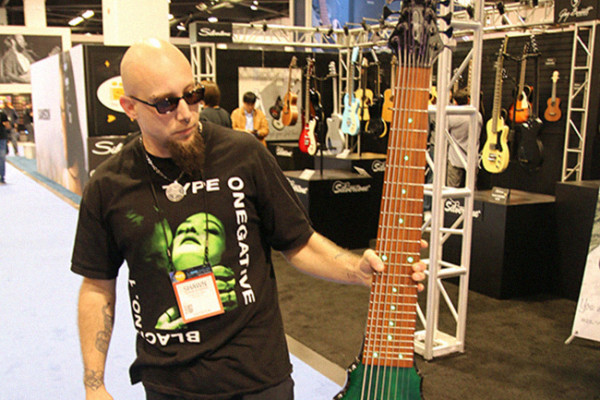
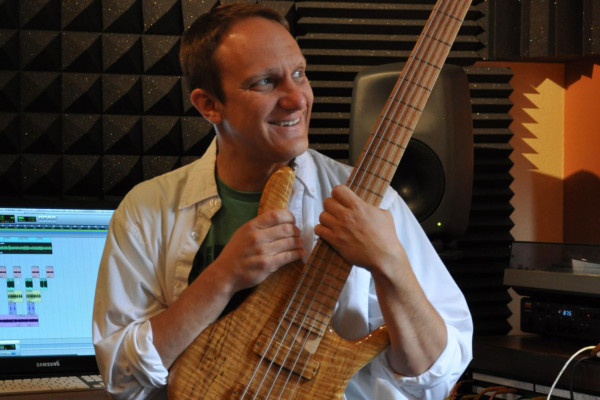
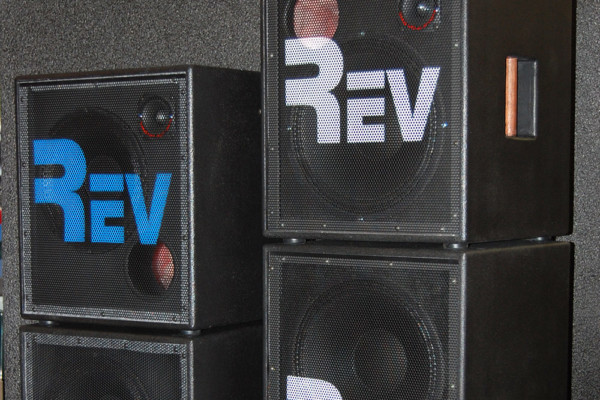
Not many basses in their shop. :(